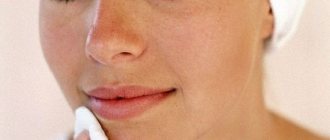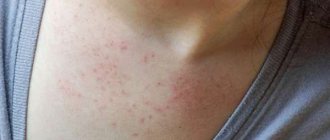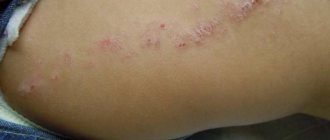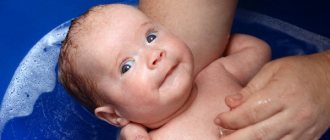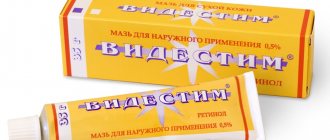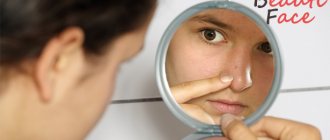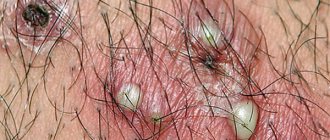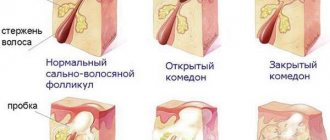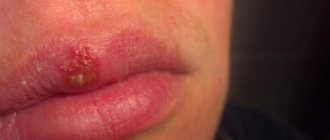Every woman wants to have smooth and soft skin all over her body, however, not everyone can boast of such skin. Often various types of pimples appear on it. They can be cosmetic in nature, harmless, or they can indicate the development of any diseases.
They don’t just happen; there is always a reason for it. Many people are often bothered by the appearance of pimples on the pubic area, which can have different colors. So they need to pay close attention, because there are enough reasons for their appearance in this zone.
With various diseases, they can have a similar appearance, so it is necessary to undergo examination by a specialist so that he can make the correct diagnosis and prescribe treatment.
Any pimples in the intimate area cause some concern and discomfort, especially with purulent contents. So why do they appear, what are the reasons? Is it worth paying attention to such invisible defects?
Causes
There is only one reason for the appearance of purulent acne on the pubis - pathogenic or conditionally pathogenic microorganisms that provoke an inflammatory reaction. Most often these are streptococci and staphylococci - the main agents that cause all pyoderma. Another question is where they came from and why they became more active. And many factors can lead to this.
- Personal hygiene errors. Irregular changes of underwear, sweat and natural discharge are excellent conditions for the proliferation of pathogenic microorganisms. Moreover, in this area of the body, which is always covered with underwear, the temperature on the surface of the skin is slightly higher than in other areas of the body, and ventilation is worse, which only aggravates the situation.
- Decreased immunity and immunodeficiency states (including those caused by taking immunosuppressive drugs). When the body’s defenses are quite weak, not only pathogenic microorganisms actively begin to multiply, but also those that are normally present on the surface of the skin, albeit in small quantities.
- Hypo- and avitaminosis, as well as metabolic disorders. Any of these conditions negatively affects the immune system and thereby increases the body's susceptibility to infection.
- Mechanical damage to the skin. Depilation using wax, sugaring or shaving. For some they pass without consequences. But in many cases, after the procedure, microtraumas of the skin remain, which are always an entry point for infection. And if we take into account errors in hygiene and weak immunity, the inflammatory process is guaranteed.
- Tight clothes, synthetic fabrics. These factors create a greenhouse effect, which is very attractive to pathogenic bacteria, which in such conditions begin to actively multiply .
- Ingrown hairs . This phenomenon after depilation and shaving is typical for many women. The hair cannot break through, bends and begins to grow parallel to the surface of the skin.
- Changes in hormonal levels. Sharp fluctuations in hormone levels occur during adolescence, pregnancy and after childbirth. Androgens are most often to blame for the development of acne. They stimulate the sebaceous glands (of which there are quite a lot in the intimate area) and change its physical properties. Because of this, it is difficult for the secretion to come out, and it begins to accumulate at the mouth of the follicle. Then everything follows a familiar scenario: hygiene errors, weak immunity, synthetic underwear with a greenhouse effect.
- Stress and other negative psycho-emotional states . They cause changes in hormonal levels and also affect the nervous and immune systems. As a result, the body’s defenses are reduced, including local immunity, which leads to the activation of previously suppressed opportunistic microflora, and also increases the body’s susceptibility to infection.
Purulent pimples on the pubic area in men appear for almost the same reasons as in women.
Complications
If left untreated, the disease can lead to complications. Genital herpes and psoriasis will constantly recur. Dermatological or fungal skin lesions gradually affect large areas of the skin. With lice or scabies, parasites can spread throughout the body.
In addition, the skin becomes more vulnerable, and secondary infections are possible. In this case, the integument swells and hurts greatly. In case of an abscess, surgical intervention, opening of the abscess and taking antibiotics are urgently required.
Diseases with the formation of purulent pimples
- Bacterial folliculitis (superficial or deep). Purulent inflammation of the hair follicle. The most common cause is Staphylococcus aureus, an opportunistic microorganism that is normally present on the skin of many people.
- Pseudofolliculitis . It develops as a result of hairs ingrown into the skin, which, after removing their shaft, begin to curl inward. At the same time, the cells around the hair continue to divide, and the sebaceous glands continue to function. However, there is no way out for their secretion along with dead epidermal cells. All this accumulates at the mouth of the follicle, forming a pimple and causing inflammation. The pathology is considered chronic.
- Pseudomonas folliculitis . It is also called “hot bath” folliculitis. The cause of inflammation is Pseudomonas aeruginosa. This microorganism can be found in insufficiently chlorinated water. You can catch the disease in a swimming pool, water park, sauna, and even at home in the bath, as well as during physical procedures if health workers carry them out in violation of sanitary rules. The rash appears after prolonged swimming in contaminated water. It is mainly localized on areas of the skin covered by a swimsuit, including the pubic area.
- Furuncle. Purulent-necrotic inflammation of the hair follicle, sebaceous gland and surrounding tissues. The most common cause is Staphylococcus aureus.
- Carbuncle. Inflammation of several hair follicles and adjacent sebaceous glands, which involves not only the skin, but also the subcutaneous tissue.
- Molluscum contagiosum. A viral disease caused by a poxvirus belonging to the group of smallpox viruses. Dense white pimples appear on the skin. However, they are not pustules, although they are somewhat similar. Therefore they are often confused. In fact, inside the nodules there is a curdled content, consisting not of pus, but of keratinized cells and dead leukocytes. The pimples themselves are painless, while with a purulent inflammatory process there is always discomfort.
- Pediculosis pubis. Purulent pimples are a secondary phenomenon that develops as a result of infection of scratches.
Folk remedies
Traditional medicine also knows several recipes that help fight acne.
They will be a good addition to the main treatment.
Photo: chamomile decoction will dry out rashes and soothe the skin
- Baths with decoctions of chamomile, sage, horsetail, celandine. A sitz bath should be performed for 5-10 minutes. The water doesn't need to be too hot, it just needs to be pleasant to the body.
Photo: calendula will relieve inflammation
- Compress made from calendula and honey tincture. In a glass of warm water, stir a teaspoon of calendula tincture and honey. Soak a cotton pad and apply to pimples for 20-30 minutes. Both components have powerful anti-inflammatory and antibacterial properties.
Photo: a decoction of nettle leaves has a blood purifying effect
- A decoction of nettle leaves is known as a good blood cleanser. It helps perfectly if acne is caused by an excess of toxic substances in the body. 2 tbsp. l. leaves, pour 0.5 liters of boiling water and infuse. Take half a glass three times a day before meals. The course of treatment is a month.
- A decoction of dandelion roots is used similarly. The crushed root is poured into a glass of hot water and boiled over low heat for 15 minutes, then left until it cools.
When to see a doctor
Any person should be alert not only to the rash, but also to the accompanying phenomena - enlargement of the inguinal lymph nodes, the appearance of peeling or redness around the pustules, an increase in pimples in size and the formation of swelling under them. A doctor's consultation is urgently needed if changes occur in the patient's general condition - increased body temperature, weakness, fatigue and other manifestations of intoxication characteristic of infectious processes.
Important! Before consulting a doctor, you should not treat the elements of the rash with brilliant green or burn them with iodine, since then the specialist will not be able to examine them in detail.
Symptoms of a boil
This disease has several stages of development, which are accompanied by such symptoms. redness appears on the pubic area or on the labia minora. You may notice swelling around the hair. Itching and discomfort appear.
severe pain occurs , because intimate places are highly sensitive than other parts of the body. The boil begins to thicken, a tubercle and swelling appear, and a pulsation is felt in the center.
The boil itself is a large pimple, it can reach 3 cm in diameter. Every day the amount of pus in it increases, and a rod matures in the middle. This disease may be accompanied by other symptoms : a rise in body temperature to 38 degrees, headache and muscle pain. If it occurs on the labia, the lymph nodes may also become inflamed, which can lead to serious consequences. Therefore, you should not delay treatment.
And at the third stage, the boil fully matures and breaks through . The tissues in the intimate places are freed from the accumulated pus and the rod that was there.
recovery begins , but you need to be very careful about hygiene in your intimate area. Despite the fact that the boil seems to be gone, the healing process is not over yet. Basically, the boil goes away in 8-12 days, but it can take longer, because this process depends on us.
But if the boil has not burst on its own after 5-7 days, then under no circumstances should you self-medicate , crush or puncture it, since microbes can enter the blood and cause serious complications; there have even been deaths. You need to urgently contact a surgeon; he will make a small incision and remove the pus. After these manipulations, the swelling will go away and the wound will heal, forming a scar.
Diagnostics
Any rash on the skin, including the pubic area, should be seen by a dermatologist. Only he can make an accurate diagnosis and select treatment. As part of the examination, the patient may be prescribed:
- clinical blood test to assess the general condition of the patient and the severity of the inflammatory process;
- analysis of immune status (immunogram);
- bacteriological culture of the contents of pustules to determine the pathogen and its sensitivity to antibacterial drugs;
- PCR diagnostics to verify the pathogenic microorganism that caused inflammation.
The list of examination methods may vary somewhat, depending on the intended diagnosis.
Scabies
Among adults, the sexual route of infection with scabies mites predominates. Therefore, symptoms often first affect the pubic area. Scabies are short, winding strips with a bubble at the end. Unbearable itching occurs, intensifying after water procedures and at night. There are special antiparasitic ointments that are applied to the entire body except the face and head.
Pimples on the pubic area are harmless in most cases. But you shouldn’t ignore them. Proper processing will help quickly get rid of defects. If the problem does not disappear, you should seek help from a dermatologist.
Treatment
Treatment of purulent acne is predominantly medicinal. Only large foci of necrosis that form with boils and carbuncles require consultation with a surgeon.
You should know. There is no universal drug therapy. The selection of medications is carried out only by a doctor, based on the diagnosis and taking into account the type of pathogen that provoked the inflammatory reaction.
Systemic therapy may include antibiotics (or antivirals), immunomodulators, and antihistamines. For external treatment, the doctor prescribes antiseptics, anti-inflammatory ointments, as well as gels that relieve discomfort (itching, soreness).
Important! It is strictly forbidden to squeeze out purulent pimples, regardless of their size.
This way you can only make the situation worse. If the pus comes out, a wound will form, which will continue to serve as an entry gate for pathogenic microorganisms. But it’s much worse if the contents of the pimple, when squeezed out, go deeper rather than outward. This will contribute to the spread of the pathological process and the formation of a new focus of inflammation.
Video: “Something came out in my groin”
Acne in the groin appears the same in men and women. First, the cause of the pathology is determined, after which specific therapy is prescribed. A rash can indicate changes within the human body, an infectious disease, or simply be a reaction to an external irritant. The main thing to remember is that any inflammation cannot be ignored, especially if the groin and pubis are affected.
Prevention
Preventive measures are quite banal and are based on eliminating factors that provoke the disease:
- strict adherence to personal hygiene;
- strengthening the immune system;
- good nutrition (prevention of vitamin deficiencies);
- wearing underwear made from natural fabrics;
- eliminating stress.
In addition, women should change the mechanical depilation methods they use to more modern methods of hardware hair removal. Laser technologies for removing unwanted hair, including in the bikini area, do not cause side effects such as ingrown hairs and folliculitis. They are completely safe and at the same time more effective.
How to get rid of acne on your pubic area
There are many simple and easily accessible resources for removing blackheads from the pubic area. Here are some of them:
Since iodine should be strictly applied only to the areas of the rash, it is best to mark the area of acne with a marker or pen before applying and then fill in the marked area with iodine.
Levomekol
This anti-inflammatory ointment should be applied to problem areas twice a day;
Hydrogen peroxide
If you treat pimples and the skin around them with hydrogen peroxide several times a day every day, the rash may subsequently disappear completely;
Vishnevsky ointment
Apply the ointment to the pimples and cover them with a piece of gauze bandage. The procedure will work best if done daily, leaving it overnight;
Aloe juice
Aloe juice not only heals wounds and has anti-inflammatory properties, but also dries out acne well. It is recommended to apply aloe juice to a gauze bandage and leave it on the site of severe acne formation overnight.
But still, we strongly recommend that you do not delay the decision to go to the doctor, and undergo the necessary tests and tests for the presence of certain diseases that accompany the formation of acne in the pubic area. The treatment options described are given only as additional or preventive.
Even if the appearance of a rash is not associated with a serious illness, the doctor will give adequate recommendations and treatment methods for each case, which will significantly facilitate and speed up the treatment process as a whole.


